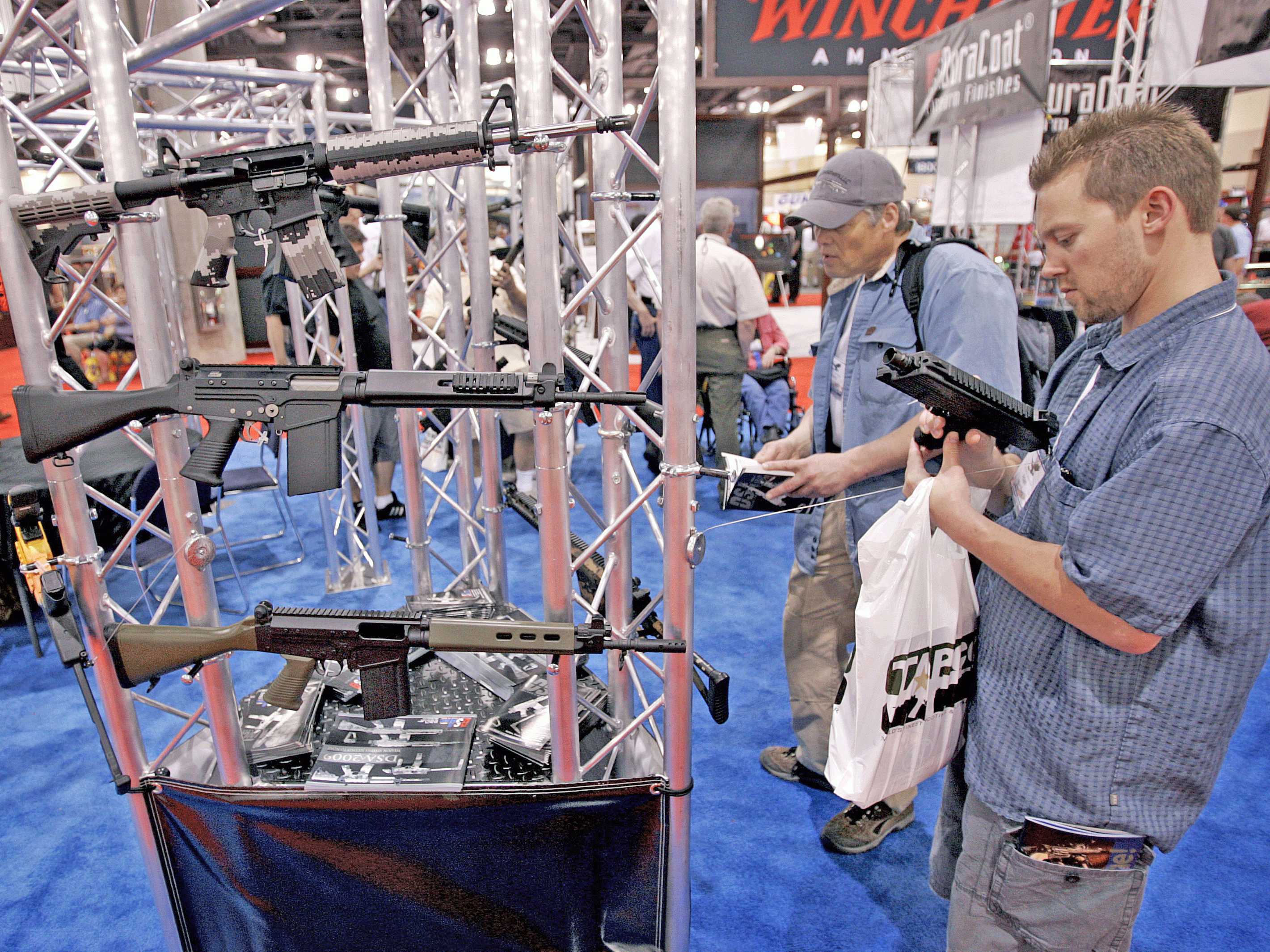- There are more than 38,000 gun deaths in the US every year, and approximately 85,000 non-fatal injuries.
- Despite some restrictions on gun research, scientists have sought to evaluate how certain policies affect gun deaths.
- Policies that seem to reduce rates of gun violence include stricter background checks, limiting access to dangerous weapons, and prohibiting domestic abusers from owning weapons.
On Sunday, a gunman opened fire at a Madden NFL video game tournament in Jacksonville, Florida. The shooter killed at least two victims and himself, and shot at least nine others.
As the country tries to figure out what – if anything – can be done in the wake of yet another mass shooting, it’s worth taking a look at the evidence we have on the effects of gun regulations.
There are close to as many guns in the US as there are people. There may be more, or there may be fewer, depending on which study you look at – there’s no exact count, since there isn’t a national database of gun purchases or firearm owners, and federal law does not require a prospective gun owner to get a license or permit.
That’s one of the many obstacles researchers come up against when trying to evaluate why so many people die from guns in the US.
But what they do know is that the number of gun deaths in the US is incredibly high. Most of these deaths are not from mass shootings, but from firearm suicides and murders. According to the American Public Health Association, guns kill more than 38,000 people per year and cause approximately 85,000 non-fatal injuries.
There's still a lot we don't know about this recent recent shooting, including whether the shooter purchased his weapon legally or if any common policy recommendations would have stopped him from obtaining a weapon.
Yet we do have evidence on effective policies that could have helped prevent some incidents. Despite some congressional limitations on gun research, scientists have sought to evaluate the effects of gun-control legislation in the US and in other places around the world.
Here's what the data shows.
Making it easier to carry concealed guns increases the number of gun homicides.

In states that have so-called right-to-carry laws, anyone who is allowed to own guns and meets the necessary conditions can also get a concealed-carry permit.
Many people have argued that right-to-carry laws deter crime because there could be more armed people around to stop a shooter. Though that idea was supported by a controversial 1997 analysis, recent and more thorough analyses have found the opposite effect.
One recent study found that such laws increased the rate of firearm homicides by 9% when homicide rates were compared state by state. That could be because confrontations were more likely to escalate to involve guns or because there were more guns around that could be stolen. Other factors could also be at play.
A spike in gun purchases after the 2012 shooting at Sandy Hook Elementary School led to an increase in accidental gun deaths, especially among kids.

Research has found that when people are around more guns, they're more likely to end up dying from accidental shootings.
After a 20-year-old man killed 20 children and six adults at Sandy Hook Elementary School in Newtown, Connecticut in December 2012, there were calls for legislation that would limit some people's access to firearms. That push resulted in what's now become a predictable phenomenon after shootings: people bought lots of guns.
With more guns around in the months after the school shooting, the rate of accidental deaths related to firearms rose sharply, especially among children, according to a recent study published in the journal Science.
The researchers' calculations showed that 40 adults and 20 children died as a result of those additional gun purchases.
Barring people convicted of domestic abuse from owning guns has a huge effect on the number of gun deaths.

The so-called Lautenberg amendment to the 1968 Gun Control Act disqualifies people with a misdemeanor conviction for domestic violence from buying or owning weapons.
Researchers found that gun murders of female intimate partners decreased by 17% as a result of the amendment.
Laws that call for longer sentences for gun crimes also seem to help a little.

Gun-robbery rates have gone down in states that have approved longer sentences for assault or robbery with a gun.
In the 1970s and 1980s, there were 30 "add-on" sentencing laws calling for additional prison time for people convicted of robbery or assault with a gun.
A 40-year-analysis found that gun-robbery rates dropped by about 5% in the years after the sentencing laws were enacted.
States that have stricter gun-control laws and spend more money on education and mental-health care have fewer school shootings.

One recent study found that states with fewer school shootings tended to have stricter background checks for weapon and ammunition purchases, and also spent more money on education and mental-health care.
Though school shootings are not the most common form of gun violence, a recent spike in these types of events in the US has prompted concern. There was an average of one school shooting per year from 1966 to 2008, but an average of one per week from 2013 to 2015, the study found.
The researchers said that based on available data, it was difficult to say which factor was most important in reducing shootings in schools.
However, mental-health treatment is unlikely to be solely responsible, as people with mental illness are more likely to be a victim of violence than a perpetrator. Though about 20% of Americans have some form of mental illness, people with a serious mental-health problem account for only about 3% of violent crime.
After Congress let a 1994 ban on assault weapons expire in 2004, gun massacre deaths skyrocketed.

Arguments about the exact meaning of "assault weapon" obfuscate an important point: When people in the US were allowed to start buying military-style firearms with high-capacity magazines, the number of people killed in gun massacres (defined as shootings in which at least six people die) shot up.
The number of gun massacres and massacre deaths decreased by 37% and 43% respectively after the 1994 ban on assault weapons went into effect, one researcher found. After it expired in 2004, they shot up by 183% and 239%.
There's debate over the effectiveness of this legislation in reducing overall gun crime or firearm deaths, since most gun deaths in the US are suicides and most murders involve a handgun.
But most of the deadliest mass shootings in recent US history have one thing in common: They involved a military-style weapon with a high-capacity magazine.
According to one study, replacing medium- and large-caliber weapons with small-caliber guns would dramatically reduce gun homicide rates.

For a study published in July, researchers examined data about 511 gunshot victims from files kept by the Boston Police Department.
They found that weapon caliber - which refers to the diameter of the firearm barrel and is an indication of the diameter of the bullet - played a big role in how fatal shootings were.
Caliber didn't affect where on the body people got shot. But people who were shot with larger bullets were more likely to die. People shot with medium-caliber weapons (defined as .38, .380, and 9 mm) were more than twice as likely to die as those shot with small-caliber guns (defined as .22, .25, and .32 mm).
People shot with large caliber weapons (.357 magnum, .40, .44 magnum, .45, 10 mm, and 7.62 × 39 mm) were more than four and a half times as likely to die as those shot with small-caliber firearms.
All in all, the researchers found that replacing large- and medium-caliber guns with small ones would have reduced homicide rates by 39.5%.
Reducing access to guns could reduce the number of suicides in the US.

Some gun-rights advocates argue that if you limit access to guns, people will just find other ways to kill themselves or others.
But data indicates that this "substitution hypothesis" is not correct.
More than 60% of gun deaths in the US are suicides, and research has found that people are most likely to try to kill themselves shortly after they decide to do so. People who attempt to do that with a gun as opposed to another method are much more likely to kill themselves.
Data from other countries supports restricting gun access, too. When the Israel Defense Forces stopped letting troops bring weapons home on the weekends, suicide rates dropped by 40%, one study found.
Historically, suicides also dropped after the UK switched from coal-gas ovens - which used a gas that people inhaled to kill themselves - to a different type of fuel. The country saw an increase in the use of other methods to attempt suicide, but it did not offset the drop in suicides by coal gas.
Weapons buy-back programs have been successful in reducing mass shootings.

After at 1996 mass shooting left 35 people dead in Australia, the country said "enough."
Leaders swiftly enacted gun-control legislation and set up a program for citizens to sell their weapons back to the government so they could be destroyed.
The initiative seems to have been successful: firearm suicides dropped by 65% and homicides by 59% over the next 10 years.
While Australia had seen 13 mass shootings - defined as five or more deaths - in the 18 years before the 1996 massacre, there has only been one in the 22 years since.
It's possible that some of those declines were due to other trends. But either way, getting many guns off the streets and out of shops was connected to big drops in gun deaths in Australia.
The American Association for the Surgery of Trauma has called for regulations that they say will make the population safer.

In a statement published in the journal Trauma Surgery & Acute Care Open on August 7, the Board of Managers for the American Association for the Surgery of Trauma issued 14 recommendations "in an attempt to stem the tide of deaths from firearm violence and support safe firearm ownership."
Their recommendations include removing firearms from domestic violence perpetrators (and those threatening violence while their cases are underway); regulating the sale of high volume ammunition, semi-automatic weapons, bump stocks, and trigger actuators; and requiring reporting of all firearm sales.
The US has a higher rate of gun violence than any other similarly wealthy country. Why not try to change that?

The US has far more mass shootings than just about any country in the world. Of countries with at least 10 million people, there are more mass shootings per capita in only Yemen, which has the second-highest per-capita rate of gun ownership (the US has the highest).
Even other countries with lots of guns, like Switzerland, have far fewer firearm deaths.
In Switzerland, however, most people gain access to weapons because of military service that provides training; other prospective purchasers have to go through a multiweek background check. Authorities there also prohibit some citizens whom psychologists deem a potential risk from owning weapons.
The US is not inherently a more violent society. What sets the country apart is that it has a lot of guns that are still really easy to get. The data that we have indicates that some gun-control measures - like banning some types of weapons, improving background checks, and putting more restrictions on weapon access - could help.
At the very least, gathering and analyzing data could help leaders determine what sort of changes might help prevent another Parkland, Las Vegas, or Sandy Hook.
Or we could do nothing and wait for the same thing to happen again.

